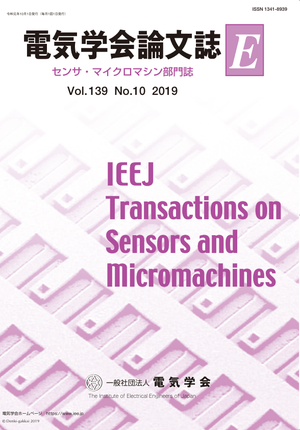Assessment of the Performance of Hydrogel Valves for Use in Ingestible Sensor Devices―Approaches for Stabilizing the pH in Microfluidic Reservoirs
Assessment of the Performance of Hydrogel Valves for Use in Ingestible Sensor Devices―Approaches for Stabilizing the pH in Microfluidic Reservoirs
カテゴリ: 論文誌(論文単位)
グループ名: 【E】センサ・マイクロマシン部門
発行日: 2019/10/01
タイトル(英語): Assessment of the Performance of Hydrogel Valves for Use in Ingestible Sensor Devices―Approaches for Stabilizing the pH in Microfluidic Reservoirs
著者名: Sven Stauss (Institute of Multidisciplinary Research for Advanced Materials, Tohoku University), Ryuichi Miyazaki (Institute of Multidisciplinary Research for Advanced Materials, Tohoku University), Itaru Honma (Institute of Multidisciplinary Research for
著者名(英語): Sven Stauss (Institute of Multidisciplinary Research for Advanced Materials, Tohoku University), Ryuichi Miyazaki (Institute of Multidisciplinary Research for Advanced Materials, Tohoku University), Itaru Honma (Institute of Multidisciplinary Research for Advanced Materials, Tohoku University)
キーワード: ingestible sensor,biocompatible microbattery,hydrogel valve,micro-Raman spectroscopy,pH measurement
要約(英語): Biocompatible microbatteries, where the gastric fluid acts as an electrolyte, have shown promise as energy sources for ingestible electronic devices. Because gastic fluid is the electrolyte, encapsulation of the microbatteries is not necessary, enabling smaller, easier-to-swallow systems, and also longer shelf lives. However, when the pH of the electrolyte increases, which occurs when the device passes from the stomach into the small intestine, the cell voltage decreases, leading to lower output power and limiting the performance of the devices.To address this problem, we propose microfluidic reservoirs that contain pH-sensitive hydrogel valves, to stabilize the pH of the electrolyte inside such microbatteries. Microstructured pH-sensitive hydrogel valves were realized using a photopatternable hydrogel and integrated in Si microreservoirs. The evolution of the valves when placed inside simulated gastric fluid (pH1.21) and then being exposed to simulated intestinal fluid (pH6.8), was observed by time-lapse optical microscopy. The pH-variation inside the microreservoirs was estimated from micro-Raman spectroscopy using methyl orange as a molecular probe. In the absence of hydrogel valves, the pH in the microreservoirs increased almost linearly, reaching a value of approximately 4.8 ± 0.3 after 26min, whereas in the case with integrated hydrogel valves, the same value was reached after 85min. Integrating of pH-sensitive hydrogel valves as diffusion barriers in microfluidic reservoirs is expected to allow more stable and longer operation of microbatteries that are activated by absorption of a biofluid such as gastric acid.
本誌: 電気学会論文誌E(センサ・マイクロマシン部門誌) Vol.139 No.10 (2019)
本誌掲載ページ: 359-365 p
原稿種別: 論文/英語
電子版へのリンク: https://www.jstage.jst.go.jp/article/ieejsmas/139/10/139_359/_article/-char/ja/
受取状況を読み込めませんでした


